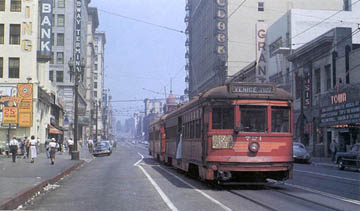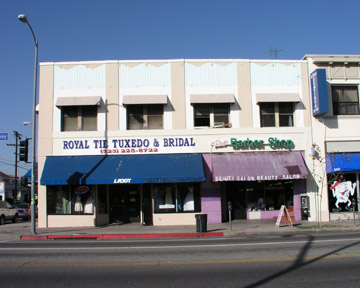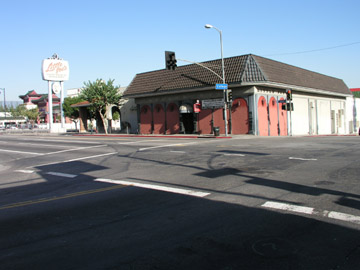
Drunko the Streetcar-Drivin’ Man is loose.
Jesse’s place, where he delved into the medicinals:
Corner of College and Main, where a plowed Viscarra plowed into poor Olga. 
For whatever reason, Little Joe’s is one of this author’s favorite buildings in Los Angeles. There’s something about that 60s Mansard/Spanish lamp/engaged arch thing-so now, I digress, because I can.
Little Joe’s grocery opened at 5th and Hewitt in 1910, moving to this location in 1923, adding the restaurant in ‘27. The neighborhood was 110% Itay at the time, ‘til Union Station displaced Chinatown and the City concocted a new one here (note the curved rooflines behind LJ’s giant backlit signage). The Nuccio family, the waitresses in red, white and green outfits, the sawdust on the floor, the Piedmonte food, hung on til 1998.
Take a look while you can, folks; Little Joe’s is being demolished by the city, in cahoots with developer Larry Bond, to become a parking structure serving the forthcoming Chinesque “Blossom Plaza†mall.
(Behind Little Joe’s is the 1831 Capitol Milling complex, slated for major additions in its morph into yet another mixed-use behemoth. Since LA is lousy with major, untouched pre-Victorian structures, the bastardization of these is just no big deal.)

I hear tell that the Museum of Neon Art may relocate into the Subway Terminal Building. The lot in front of the STB, where the Philharmonic Auditorium used to be, is going to have a big-ass high rise constructed upon it.
A word about (founder of the Pacific Electric Railway) Eli P. Clark’s namesake: I love the Clark more than I can say. When it opened in January 1914, it had the largest marble lobby in the West. Every room had a bath. The circles of finance, letters and society made there way there in droves. Woodrow Wilson slept there, as did William Jennings Bryan, Alexander Woolcott, and Tom Mix. And yet in 1947 it was downtown’s one integrated hotel. Yeah, you always hear about black musicians staying at the Dunbar on Central and 42nd — but Duke and the Count and many others stayed at the Clark. And yet, again, the Colonial Dames met there in 1955. Huh.
The Clark used to have really cool finials and a giant rooftop sign and a big ghost sign that you can still sort of see when the light is right. The deco blade sign makes my heart quop. This picture is the only one I’ve seen where the sign is black. In my postcards and such it is always white. One of those Steve Harvey bits in the times noted that that malfunctioning blade read “el Clark” in 1979. I don’t know when it closed. I’m itching to go in, despite, or because of, the new lobby that was installed in 1953.
From what I’ve heard, the Sunday Inn Group, Japanese investors who purchased the Clark in 1979, who tore down the roof sign, and who tried to evict all the old pensioners, may still own it. Although I’ve also heard it’s owned by the Chinese government now. And I suppose it’s also true that Chetrit and Associates are rehabbing the Clark into a hotel again, and God willing, they will relight the neon.
And yes, the Town Theater (known in the early 20s as “Bard’s Cinema Theatre” and designed by none other than A. C. Martin, and which became the VERY FIRST Pussycat adult theater in the late 60s)is gone–totally razed. It became a McDonald’s in 1985 and now is a place that makes silver jewelry.
On p. 96 of “Los Angeles Neon” there’s a teens/1930s/modern Clark comparison. Shameless plug.
The Subway Terminal blade was opal glass, by the way.
At the Town on this date in 1947, you could see Deanna Durbin in the saccharine “Because of Him,” and the existentially-named Zane Grey western “Wanderer in the Wasteland.”
My God, I should really go to bed.